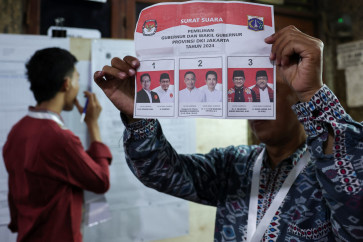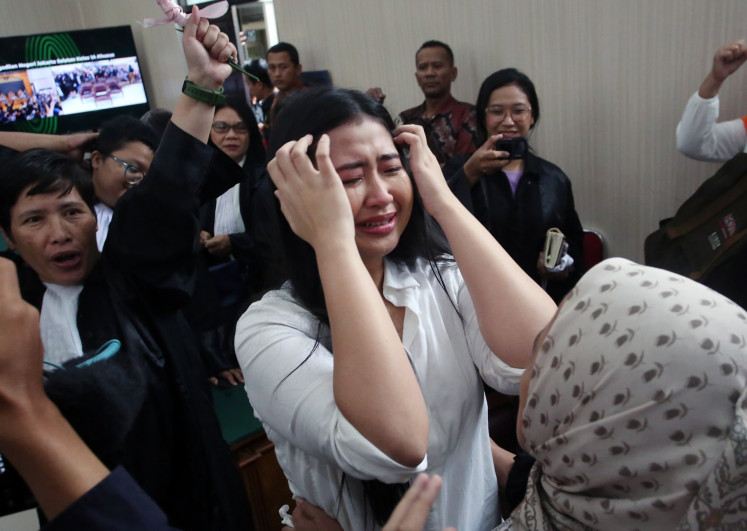Popular Reads
Top Results
Can't find what you're looking for?
View all search resultsPopular Reads
Top Results
Can't find what you're looking for?
View all search resultsReducing the vulnerability of our electricity supply system
JP/R
Change text size
Gift Premium Articles
to Anyone
JP/R. Berto Wedhatama
Electricity shortages, blackouts and brownouts have become common phenomena in Indonesia, including in the capital Jakarta recently.
Elsewhere in Indonesia, including world-class oil- and coal-producing regions like East Kalimantan and Riau, electricity shortages have long been an ironic truth for the local people.
An electricity shortage is actually a phenomenon which can be predicted long before it happens.
Securing operation (mainly for primary energy supply) and securing investment needed to add the coverage of our electricity services are the two key factors that have to be managed prudently if we want to keep the services in this archipelago sustainable. These tasks are quite challenging.
Demand for electricity can be seen simply as a function of economy and the size of the population. As we want to keep our economy growing (our population is increasing naturally), we have to provide electricity to materialize the growth.
State-owned electricity company PT PLN has been doing well in making correlations between the economy and the population, with demand for electricity for all regions in Indonesia. In its annually published “Planning for Electricity Provision”, PLN derives the demand for electricity to the requirement for infrastructure to be built (generators, transmission, sub-stations, etc.) for a 10-year planning horizon.
However, it is difficult for PLN — which has a monopoly on power distribution — to deliver the demanded infrastructure sufficiently. Lack of investment is the main reason. The revenue from selling electricity (with the rate set by the government) is not large enough to cover operational costs; moreover, there is no investment to construct new infrastructures. The government has so far tried to help PLN by participating in investment provision, but the amount it contributes is usually far below that requested.
Since PLN has long had difficulty finding other financing sources, the quantity of electricity infrastructures built lagging behind that actually required.
For instance, up into 2018, PLN will need about US$58.5 billion in investment ($31.7 billion for generators, $14.4 billion for transmission and $12.3 billion for distribution networks), but it is not sure how much and from where the fund can be secured.
Not only that, PLN faces severe investment problems and also operational costs to run its day-to-day machines.
The electricity business basically converts primary energy (coal, diesel, natural gas, water, geothermal, etc.) into electrical energy. The cost of providing primary energy plays a crucial role in the business since it serves as the largest part of costs the utility has to provide as long as its generators operate.
The difficulty here is, while the electricity rate on the downstream side is set by the government, primary energy is supplied from a liberal system far from government control.
Managing a good balance between the liberal system on the upstream side and regulated system on the downstream side is one of the most difficult tasks the PLN management faces.
The fluctuation and trend in fossil fuel prices has put PLN in a more risky position. PLN’s fuel mix — especially in the outer islands — is still dominated by fossil fuels, meaning the volatility of fossil fuel prices (especially that of oil and coal) will directly affect PLN’s vulnerable revenues and its ability to dispatch electricity. PLN’s position is also very weak if it has to compete with external pressures highly demanding Indonesia’s fossil fuels or those who make the commodities more difficult to be found domestically.
However, strategic proposals can be offered to reduce the vulnerability of our electricity supply system.
To address lack of investment, re-inviting private sector participation and developing (central and local) government responsibilities are the major keys. Given the growing constraints, it is impossible that the giant PLN will be able to serve electricity to all parts of this diverse archipelago, which currently operates more than 300 electricity systems.
In a country where access to electricity is still limited, adding infrastructure to the current installed capacity is a task to solve not only by the assigned utility industry (PLN), but also the governments, both central and regional (provincial, regency and municipal), which have to play more active roles.
A system that is more suited to the regional condition (energy sources available locally, rate representing the region’s ability to pay and costs of delivering electricity, etc.) must be developed faster and more widely. The capacity of non-PLN resources (including regional government officers, local businesses and financiers, etc.) to cope with electricity and wider energy issues must be built faster. Not an easy challenge, but Energy Law No. 30/2007 and Electricity Law No. 30/2009 have opened the possibility and instructed to take the job, especially to the regional governments.
Securing primary energy supplies (reducing risk from uncertainty in primary energy prices) can be realized by strategically developing two of our indigenous energy resources: geothermal and natural gas.
Geothermal is clean, not exportable, our reserves are the largest in the world, the share of geothermal in our power mix is still very small (less than 4 percent), its dispatching cost is low while total costs for operating geothermal plants along its economic life can be cheaper and more predictable than that of fossil fuel ones. Taking those factors and our worsening energy security into account, do we still have objections to developing our geothermal at a quicker pace?
Natural gas, like electricity, is a kind of energy requiring (inflexible) infrastructures to be built first before the energy can be delivered to its customers. Compared to oil and coal, which can be transported more easily and flexibly, the inflexibility of natural gas infrastructure is the weak but also the strong characteristic of this energy source.
So far, the natural gas industry in this country has developed infrastructure connecting gas fields in the archipelago with gas consumers abroad in a much more intensive way than the
one to support domestic demand. We may now take the adverse way by building much more infrastructure (transmission, distribution) prioritizing our growing demand, which actually costs less than the complex one for export purposes.
Once the infrastructure has been built — as our own experiences in developing large-scale natural gas transmission, particularly in Sumatra, also suggest — it will create more exploration and more natural gas production activities that we may now deliver to feed our power plants. The natural gas infrastructure around major cities, particularly bringing gas to Java, should be given priority to be built first.
The writer is an energy planner and economist with the National Development Planning Agency (Bappenas). The opinions expressed are his own.










